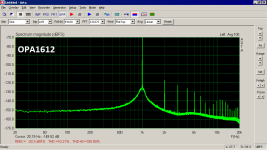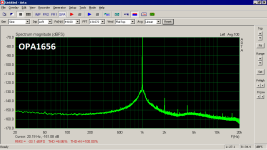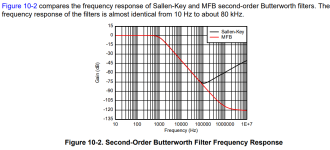By not usually in the small signal regime you are implying low-bandwidth small-signal regime I think - small signals don't have to have small derivatives...
It depends on bandwidth. In da 21st century, nearly ALL music sources have brickwall bandwidth. AjohnL has some of the maths and if my single brain cell wasn't already overloaded, I'd show the rest of the math for worst case.
ANY music signal today that exceeded the slew of 5534 would be SEVERELY OVERLOADED. Then the main audible effect isn't 'slew' but OVERLOAD RECOVERY.
And what do you think is the audible effect of slew limiting on overload? It turns a 'square' wave into sorta a 'rhomboidal' shape which means less yucky high order artifacts and sounds better. Overload behaviour is a HUGE topic but probably the most important factor in the 'sound' of electronics (and speakers) today.
What we really want is amps, OPAs with 1ppm THD @ 20kHz right up to clipping and slew limiting to twice that value under overload, no nasty 'blocking', bla bla. You can buy such beasts from Ye Olde Unobtainium Shoppe. I was involved in the design of such an amp in Jurassic times. It sounded good but we felt da reviewers would pan it cos this was an era of fashionable zillion V/us
ANY music signal today that exceeded the slew of 5534 would be SEVERELY OVERLOADED. Then the main audible effect isn't 'slew' but OVERLOAD RECOVERY.
And what do you think is the audible effect of slew limiting on overload? It turns a 'square' wave into sorta a 'rhomboidal' shape which means less yucky high order artifacts and sounds better. Overload behaviour is a HUGE topic but probably the most important factor in the 'sound' of electronics (and speakers) today.
What we really want is amps, OPAs with 1ppm THD @ 20kHz right up to clipping and slew limiting to twice that value under overload, no nasty 'blocking', bla bla. You can buy such beasts from Ye Olde Unobtainium Shoppe. I was involved in the design of such an amp in Jurassic times. It sounded good but we felt da reviewers would pan it cos this was an era of fashionable zillion V/us
Funasaka (4558 @ 300V/µs) is one example: https://www.proaudiodesignforum.com...S_v30n5_Feedforward_Floating_Power_Supply.pdf"In the past fairly decent designs have even been based on 741's."
On what planet in what universe is that true?
To get that you certainly have to work for it with a lot of external stuff.
Last edited:
I didn't bother replying as I mentioned pre amp. Say max out is 1v rms. Peak slew rate is 0.126v / uSec at 20kHz.. 2v rms is still well under what a 741 is capable of.
Noise - modern stuff can do a lot better but levels being fed in figures in that as well. They were mostly used for tone controls and mixers etc.
Noise - modern stuff can do a lot better but levels being fed in figures in that as well. They were mostly used for tone controls and mixers etc.
BJT input opamps are RF detectors as they have pn-junctions biased just into slight conduction at the front-end, making them sensitive to even a few mV of RF. This is why you should keep RF out of your enclosure in the first place, and filter it out using audio input networks on the PCB too. FET inputs are reverse biased pn-junctions or MOS-structures, neither of which has rectifying action (at low voltages at least), and are much less sensitive for a given RF voltage.
the OPA1612 is some kind of WiFi detector.
The BJT one appears to have back to back diode protection across it's inputs and notes such as a low value resistor may be needed in series with the output with capacitive loads. An applications is shown that use relatively low value resistors when connected to a DAC. A rather specific use.
The FET one is a different kettle of fish. Some more usual values of R in the usual circuits. That one may benefit from guard rings on it's inputs even ones to the external world.
Both look to need care with layout.
Maybe the problem with the BJT one is what it's been used for during your tests?
In super close proximity I can make most bipolar input op amps in my stash rectify WiFi and DECT RF envelopes but the LM4562/LME49720 can sniff a DECT 6 base station from across the room. It's sensitivity is outstanding. I've often wondered if its input structure ESD diodes or whatever resonate to make it so sensitive.
"Also, for audio use, I see no benefit to having [opamp frequency response] out to 10 MegaHz"
A lot of people want this because they want to maximize the amount of feedback available at the top of the audio band, 20 kHz. More feedback means more "error correction" / distortion reduction. Which means lower distortion. Which is their goal.
Agreed! - this, and your subsequent posts : )
However there is another audio use that can justify wanting , no: needing serious OL-bandwidth, and that is active filters - specifically Sallen-Key types - depending on what you want to achieve.
Easy to 'design' accurate, useful filters to any alignment you like - but the hidden 'gotcha' is that high performance out of a 2-pole Sallen-Key type can require near-20MHz bandwidth, and good current delivery, and is not a trivial problem to simply pick-a-part (esp not ' diyaudio flacour of the month' ) on the opamp and ...get predicted performance. At all. Another instance when really good decoupling strategies, and layout - are absolutely more important than on-paper specs.
Edit - 1 page summary added for anyone interested. It gets more interesting from here...
Attachments
That's why lots of engineers have abandoned the Sallen-Key active filter and embraced the Multiple FeedBack active filter instead. MFB gives much much better results with nonideal opamps.
Or, for stubborn traditionalists, stay with Sallen-Key BUT use Emitter Followers with constant current source loads as your unity gain elements. You can get 100 MHz bandwidths from jellybean parts in TO-92 packages.
_
Or, for stubborn traditionalists, stay with Sallen-Key BUT use Emitter Followers with constant current source loads as your unity gain elements. You can get 100 MHz bandwidths from jellybean parts in TO-92 packages.
_
Attachments
Its also got a lot more open loop gain than most bipolar opamps...In super close proximity I can make most bipolar input op amps in my stash rectify WiFi and DECT RF envelopes but the LM4562/LME49720 can sniff a DECT 6 base station from across the room. It's sensitivity is outstanding.
You are 100% sure of your measurement setup? You are not seeing artefacts of the fft? When I see such things measured out of a very respectable lab my first suspect is the measurement.
@Havoc Turning of the DECT 6 base station and unpowering a nearby WiFi access point or changing the op amp part number makes it go away. Not sure how that could be an FFT measurement error. The frequency of the rectified spurs also correspond to DECT 6 beaconing/pinging. WiFi has similar spurs but at slightly different, but LF, repetition rates. Shielding of the DUT obviously helps but conducted interference through signal leads persists. There have been at least a half-dozen of us who have independently discovered this over the last few years.
@Mark Tillotson "Amplifying" your point. Most of that extra open loop gain is at DC and infrasonic LF exaggerating the problem. In comparison a 5532 and LME49720/4562 have similar OL gain at 1 kHz but the typical 5532, at DC, maxes out around 90 dB whereas the LM4562 has around 130-140 dB. For GHz-range RF envelopes the LM4562 is a rectifier followed by a high gain DC amplifier.
@diyralf "After all, as long as the harmonics stay below -120dB they are not audible." Yes, but for my customers I don't want to have to explain why the FFTs looks like a comb when it's near a phone or WiFi access point. The burst noise, if it's still in current product, is definitely a deal-breaker. TI may have fixed it in process but they admit they don't test for it.
@Mark Tillotson "Amplifying" your point. Most of that extra open loop gain is at DC and infrasonic LF exaggerating the problem. In comparison a 5532 and LME49720/4562 have similar OL gain at 1 kHz but the typical 5532, at DC, maxes out around 90 dB whereas the LM4562 has around 130-140 dB. For GHz-range RF envelopes the LM4562 is a rectifier followed by a high gain DC amplifier.
@diyralf "After all, as long as the harmonics stay below -120dB they are not audible." Yes, but for my customers I don't want to have to explain why the FFTs looks like a comb when it's near a phone or WiFi access point. The burst noise, if it's still in current product, is definitely a deal-breaker. TI may have fixed it in process but they admit they don't test for it.
Last edited:
I have the same experience with mediatechnology. From the output of the LM4562 in the test circuit, a waveform similar to the photo in post #22 is observed by RF demodulation of the WiFi router in the next room 4 meters away.
If I operate a WiFi device or move a Bluetooth mouse nearby, it will make a loud burst noise.
It was more than 12 years ago that I noticed that the LM4562 was EMI sensitive, and I thought that OP-amps with wide bandwidth might be sensitive to EMI. However, LME49990, which was released later and had wider bandwidth, had no problems. The Rbb' and tail current of the input stage Tr should have been changed to reduce voltage noise, but I assume that the process and topology are the same...
Since my experience with the LM4562, I have become more careful with EMI. Of course, I'm an amateur, so this is just a simple check.
The only EMI sensitive OP-amps other than the LM4562 (and its variants) that I have noticed are OPA209 and THS4031. They are not as bad as the LM4562, but they are worth paying attention to. THS4031 has wide bandwidth, but OPA209 is not so large.
If I operate a WiFi device or move a Bluetooth mouse nearby, it will make a loud burst noise.
It was more than 12 years ago that I noticed that the LM4562 was EMI sensitive, and I thought that OP-amps with wide bandwidth might be sensitive to EMI. However, LME49990, which was released later and had wider bandwidth, had no problems. The Rbb' and tail current of the input stage Tr should have been changed to reduce voltage noise, but I assume that the process and topology are the same...
Since my experience with the LM4562, I have become more careful with EMI. Of course, I'm an amateur, so this is just a simple check.
The only EMI sensitive OP-amps other than the LM4562 (and its variants) that I have noticed are OPA209 and THS4031. They are not as bad as the LM4562, but they are worth paying attention to. THS4031 has wide bandwidth, but OPA209 is not so large.
- Home
- Source & Line
- Analog Line Level
- Surprising op amp measurements


